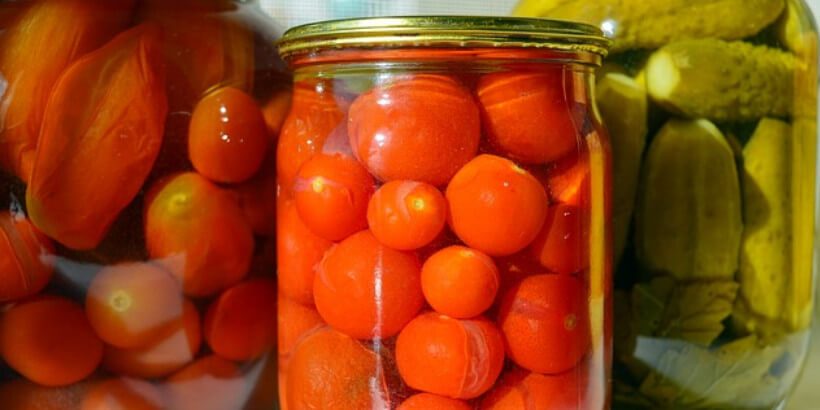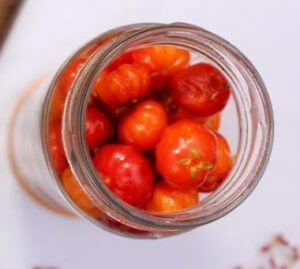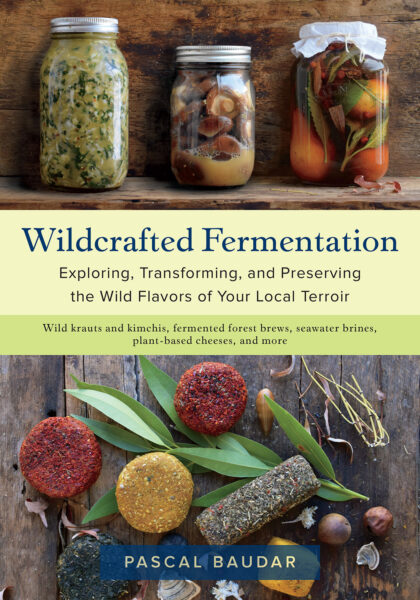Preserving Vegetables in Salt: Whole Tomatoes

Buying fresh produce feels like a waiting game — if you blink, your food will go from ripe to rotten all too soon. Beat this game by preserving vegetables, such as tomatoes, in salt. This process will keep them fresh and ready for sauce, stock, and more.
The following is an excerpt from Preserving Food Without Freezing or Canning by The Gardeners & Farmers of Terre Vivante. It has been adapted for the web.
Preserving Vegetables in Salt
Above a certain concentration of salt in food, microorganisms cannot develop and thus the preservation of food is assured.
While preserving with salt seems a relatively ancient process, it is not as old as [other] methods…At one time, salt was mainly used for preserving meat, fish, and butter; every rural household had a salt tub. Today, salt still is used for fish, such as cod or anchovies, as well as for pork and butter. Among vegetables, we sometimes salt green beans, herbs, and vegetable mixtures for soup stock.
What to Know Before Preserving Vegetables
There are two main disadvantages to preserving food with salt:
- The salt must be removed from most foods before consuming them, which usually requires lengthy soaking and repeated rinsing that also eliminate some of the nutrients;
- If the salt is not completely removed, we risk consuming more than is considered healthy these days.
However, for preserving foods that we eat in small quantities, or that don’t need much soaking and rinsing, salt has its place. It is one of the best ways to preserve fish, for which other methods tend to be less convenient. Green beans seem to be the vegetable that best lends itself to being preserved with salt.
Preserve Mixed Vegetables In Salt
There are many versions of this method of preservation, and we have included in this chapter several of the most common ones. Yet, among all the foods preserved with salt, mixed vegetables are perhaps the most appealing: no salt need be removed; they do not cause you to eat too much salt; and they make instant stock for soup.
 Preserving Whole Tomatoes
Preserving Whole Tomatoes
Ingredients
- Tomatoes
- Olive oil
- Salt
- A saucepan
- Glass jars and lids
Procedure
- Make a brine (one-quarter cup salt to one quart of water), and bring it to a boil.
- Allow to cool.
- Choose firm tomatoes, preferably (‘Campbell’ variety, for example), wash and dry them carefully, and put them in glass jars.
- Pour in the cooled brine, up to one and a quarter inches below the rim, and fill in the remaining space with olive oil to cover.
- Close the jars airtight and store them in a cool place.
These tomatoes will keep for nine to ten months; use them for sauces.
Recommended Reads
Recent Articles
Oh, honeysuckle…how we love thee. If only there was a way to capture the sweet essence of this plant so we could enjoy it more than just in passing. Luckily, foraging and some preparation can help make that happen! Here’s a springtime recipe that tastes exactly like honeysuckle smells. The following excerpt is from Forage,…
Read MoreIntroducing…your new favorite brunch dish! This whole broccoli frittata is packed with fresh, wildcrafted flavors that are bound to help you start your day off on the right foot. The following is an excerpt from The Forager Chef’s Book of Flora by Alan Bergo. It has been adapted for the web. RECIPE: Whole Broccoli Frittata…
Read MoreWondering where to forage for greens this spring? Look no further than hedges, which serve as natural havens for wild greens and herbs! The following is an excerpt from Hedgelands by Christopher Hart. It has been adapted for the web. Food from Hedges: Salads and Greens Let’s start by looking at all the wild foods…
Read MoreThere’s a whole new world out there when it comes to koji. It doesn’t matter if you’re making bread, cheese, or ice cream, koji helps you pump up the flavor! Growing Koji in Your Own Kitchen Koji, the microbe behind the delicious, umami flavors of soy sauce, miso, fermented bean sauce, and so many of…
Read MoreWhether you’re looking to replace your end-of-the-day cocktail, relax before bed, or want something new to add to your tea, this non-alcoholic mocktail syrup base will do the trick. Delicious and all-natural, take a sip of this nightcap mocktail and feel your troubles melt away. The following is an excerpt from Herbal Formularies for Health…
Read More








